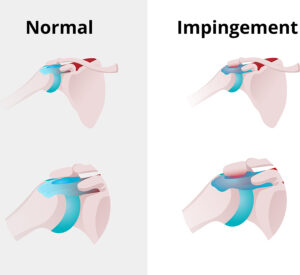Shoulder impingement is a form of inflammation in a small part of your shoulder. It starts as a small sharp pain, but could be painful, stubborn, and downright debilitating. Common in athletes, impingement is caused by overuse. It is important to see a doctor as soon as you show signs of shoulder impingement, but what are the symptoms?
3 Signs of Shoulder Impingement
1. Pain
The first sign of injury is pain. Shoulder impingement pain is normally minor but constant in the front of your shoulder and on the side of your arm. People tend to ignore initial signs of pain, hoping that the problem will fix itself. When it comes to major joints such as this one, it is important to address your symptoms right away.
 2. Weakness
2. Weakness
Your rotator cuff is what attaches your arm to your shoulder. This group of muscles protects your shoulder joint and allows you to move it freely. When you lift your arm, the space between your rotator cuff and narrows. Regular use can increase pressure, causing swelling in this area and irritation. When it leads to impingement, your muscles weaken with the pain. Ignoring this can lead to more severe injuries in the shoulder, such as a rotator cuff tear.
3. Clicking or Popping
When you experience a popping sensation in your shoulder, it is your rotator cuff rubbing against your Acromion (shoulder bone.) When it happens consistently, it may be a sign you have inflammation. If ignored, the tissue in that space can become thicker making you’re prone to more severe injury in that area.
How Can a Physical Therapist Help?
Strengthen
Your physical therapist will show you how to use exercises with the proper technique in order to strengthen your weakened muscles.
Improve Motion
Manual physical therapy is when a physical therapist performs movements on the areas that need rehabilitation. By gently moving your shoulder, your physical therapist can bring back full motion to your injured shoulder.
Shoulder Surgery or Physical Therapy?
Depending on the severity of your injury, physical therapy alone could help heal shoulder impingement and pain. “Physical therapist-led exercises show equal effectiveness compared with surgery in the long term in patients with shoulder impingement syndrome,” say authors in the Journal of Rehabilitation Medicine.
The study consisted of 2 treatment groups: the first was strictly exercise, the second had surgery and a structured exercise program. After the 24 month period, “The combined treatment cost considerably more .. Structured exercise treatment should be the basis for the treatment of shoulder impingement syndrome, with operative treatment offered judiciously until its true merit is proven.” Journal of Bone and Joint Surgery.
When to see a doctor
The first sign you might have a problem is an ache you can feel when reaching overhead. This will feel more like an annoyance, and usually can be treated by icing. If the pain gets worse, it may be a sign you have impingement due to something other than swelling, and it is time to see a doctor. When you see a doctor to assess your shoulder pain, an x-ray will determine the cause.
If you are experiencing shoulder pain in any form, it is important to see a doctor for treatment as soon as possible. The longer you ignore your pain, the more chance there is for greater injury. If you have any questions or want to schedule a physical therapy session, contact any of the ECRC physical therapy offices.

